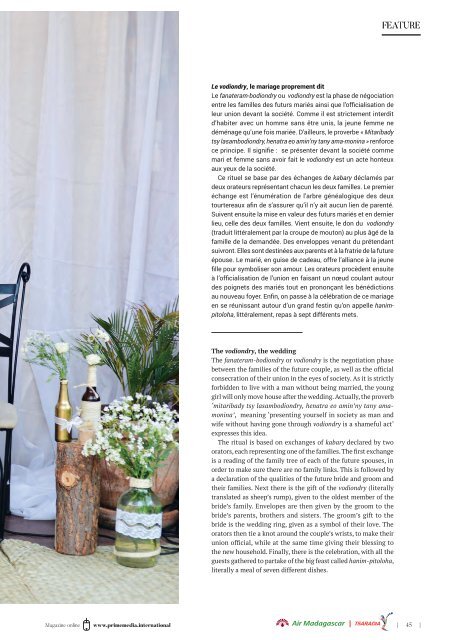Prime Magazine November 2020
Create successful ePaper yourself
Turn your PDF publications into a flip-book with our unique Google optimized e-Paper software.
FEATURE<br />
Le vodiondry, le mariage proprement dit<br />
Le fanateram-bodiondry ou vodiondry est la phase de négociation<br />
entre les familles des futurs mariés ainsi que l’officialisation de<br />
leur union devant la société. Comme il est strictement interdit<br />
d’habiter avec un homme sans être unis, la jeune femme ne<br />
déménage qu’une fois mariée. D’ailleurs, le proverbe « Mitaribady<br />
tsy lasambodiondry, henatra eo amin’ny tany ama-monina » renforce<br />
ce principe. Il signifie : se présenter devant la société comme<br />
mari et femme sans avoir fait le vodiondry est un acte honteux<br />
aux yeux de la société.<br />
Ce rituel se base par des échanges de kabary déclamés par<br />
deux orateurs représentant chacun les deux familles. Le premier<br />
échange est l’énumération de l’arbre généalogique des deux<br />
tourtereaux afin de s’assurer qu’il n’y ait aucun lien de parenté.<br />
Suivent ensuite la mise en valeur des futurs mariés et en dernier<br />
lieu, celle des deux familles. Vient ensuite, le don du vodiondry<br />
(traduit littéralement par la croupe de mouton) au plus âgé de la<br />
famille de la demandée. Des enveloppes venant du prétendant<br />
suivront. Elles sont destinées aux parents et à la fratrie de la future<br />
épouse. Le marié, en guise de cadeau, offre l’alliance à la jeune<br />
fille pour symboliser son amour. Les orateurs procèdent ensuite<br />
à l’officialisation de l’union en faisant un nœud coulant autour<br />
des poignets des mariés tout en prononçant les bénédictions<br />
au nouveau foyer. Enfin, on passe à la célébration de ce mariage<br />
en se réunissant autour d’un grand festin qu’on appelle hanimpitoloha,<br />
littéralement, repas à sept différents mets.<br />
The vodiondry, the wedding<br />
The fanateram-bodiondry or vodiondry is the negotiation phase<br />
between the families of the future couple, as well as the official<br />
consecration of their union in the eyes of society. As it is strictly<br />
forbidden to live with a man without being married, the young<br />
girl will only move house after the wedding. Actually, the proverb<br />
‘mitaribady tsy lasambodiondry, henatra eo amin’ny tany amamonina’,<br />
meaning ‘presenting yourself in society as man and<br />
wife without having gone through vodiondry is a shameful act‘<br />
expresses this idea.<br />
The ritual is based on exchanges of kabary declared by two<br />
orators, each representing one of the families. The first exchange<br />
is a reading of the family tree of each of the future spouses, in<br />
order to make sure there are no family links. This is followed by<br />
a declaration of the qualities of the future bride and groom and<br />
their families. Next there is the gift of the vodiondry (literally<br />
translated as sheep’s rump), given to the oldest member of the<br />
bride’s family. Envelopes are then given by the groom to the<br />
bride’s parents, brothers and sisters. The groom’s gift to the<br />
bride is the wedding ring, given as a symbol of their love. The<br />
orators then tie a knot around the couple’s wrists, to make their<br />
union official, while at the same time giving their blessing to<br />
the new household. Finally, there is the celebration, with all the<br />
guests gathered to partake of the big feast called hanim-pitoloha,<br />
literally a meal of seven different dishes.<br />
<strong>Magazine</strong> online<br />
www.primemedia.international<br />
| 45 |
















